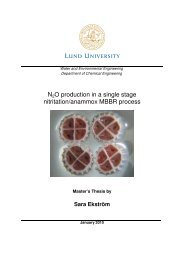Alexander Szabo and Oscar Engle - Svenskt Vatten
Alexander Szabo and Oscar Engle - Svenskt Vatten
Alexander Szabo and Oscar Engle - Svenskt Vatten
You also want an ePaper? Increase the reach of your titles
YUMPU automatically turns print PDFs into web optimized ePapers that Google loves.
2.2 Pretreatment<br />
<br />
Screening<br />
The purpose of a screening device, which is located before the treatment pond, is to remove<br />
coarse materials like pieces of plastic <strong>and</strong> woods etc. The material caught <strong>and</strong> removed from the<br />
screen is often of inorganic characteristics <strong>and</strong> hard to break down biologically in the treatment<br />
pond. The coarse material can also damage pumps <strong>and</strong> aerators used in the subsequent treatment<br />
stages.<br />
It is recommended that the water velocity through the screen should be less than 1 m/s so coarse<br />
material will be able to stick between the screens (Mara, 2003). The space between the bars<br />
should be between 15-25 mm (Mara, 2003). If the flow is above 1000 m 3 /day mechanical screens<br />
which automatically remove the captured objects should be used instead of screens that have to<br />
be maintained manually. This is because mechanical screens can be cleaned more frequently. It is<br />
although wise to have a screen that could be cleaned by h<strong>and</strong> as a back-up for the mechanical<br />
screen in case the mechanical screen would stop working. The waste products collected from the<br />
screen can be taken to the nearest l<strong>and</strong>fill or be incinerated.<br />
Grit removal<br />
Grit is made up of heavier <strong>and</strong> smaller particles (often of inorganic characteristics) like glass,<br />
s<strong>and</strong> eggshells etc. Grit can damage pumps <strong>and</strong> aerators in the subsequent treatment steps <strong>and</strong><br />
should be removed before the treatment pond if the waste water contains large quantities.<br />
Before water enters the screen <strong>and</strong> the treatment pond, the waste water may flow in long grit<br />
channels where the water passes through at a desired velocity. The heavier grit particles will settle<br />
in the channel as the waste water flows through. The grit channels are made up of two parallel<br />
channels so one of the channels can be closed for grit removal. A possible problem with a grit<br />
channel is that it is difficult to keep the velocity at a constant level (Mara, 2003). <br />
2.3 Pond Types<br />
Anaerobic ponds<br />
Anaerobic ponds operate without the presence of algae or oxygen, <strong>and</strong> have an advantage over<br />
the facultative pond since they can deal with higher organic loading. They can reduce the organic<br />
load by 40 to 70% with a retention time of only a few days (Shilton et al., 2005).<br />
Methane (CH 4 ) <strong>and</strong> sulphide (H 2 S) are gasses that are produced under anaerobic conditions.<br />
Methane gas may be considered as a fuel resource if collected, but if not collected as a<br />
greenhouse gas, contributing to the climate change as it escapes into the atmosphere from the<br />
pond. If sulphide is produced <strong>and</strong> released, it is not appreciated since it is releases a bad odor. If<br />
the anaerobic pond is not properly design, or when overloaded, the release of sulphide may be<br />
problematic for people living in the surroundings (Mara, 2003). This is confirmed by a study at<br />
Lee Summit WSP, Missouri, where odor nuisance occurred after the load was increased above the<br />
pond capacity (McKinney, 1968).<br />
<br />
17















